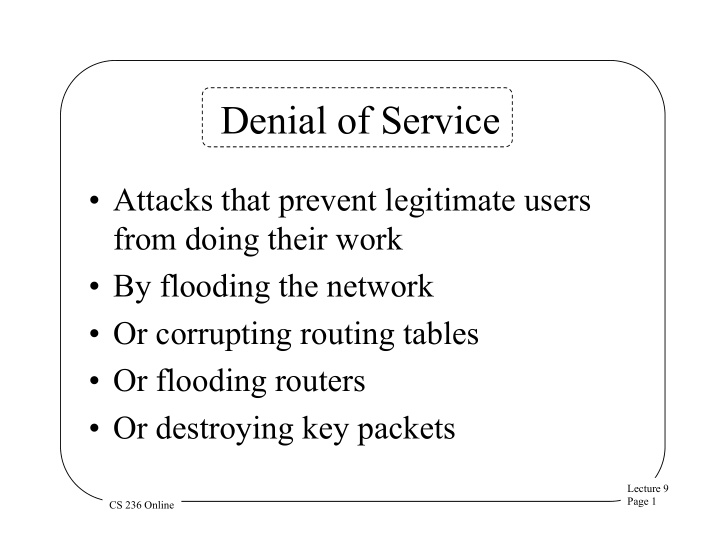



Denial of Service • Attacks that prevent legitimate users from doing their work • By flooding the network • Or corrupting routing tables • Or flooding routers • Or destroying key packets Lecture 9 Page 1 CS 236 Online
How Do Denial of Service Attacks Occur? • Basically, the attacker injects some form of traffic • Most current networks aren’t built to throttle uncooperative parties very well • All-inclusive nature of the Internet makes basic access trivial • Universality of IP makes reaching most of the network easy Lecture 9 Page 2 CS 236 Online
An Example: SYN Flood • Based on vulnerability in TCP • Attacker uses initial request/response to start TCP session to fill a table at the server • Preventing new real TCP sessions • SYN cookies and firewalls with massive tables are possible defenses Lecture 9 Page 3 CS 236 Online
Normal SYN Behavior SYN SYN/ACK ACK Table of open TCP connections Lecture 9 Page 4 CS 236 Online
A SYN Flood SYN SYN SYN SYN SYN/ACK SYN/ACK SYN/ACK SYN/ACK Server can’t Table of open fill request! TCP connections Lecture 9 Page 5 CS 236 Online
And no changes KEY POINT: to TCP protocol Server doesn’t SYN Cookies itself need to save SYN/ACK number is cookie value! Client IP address & port, server’s secret function of IP address and various information port, and a timer No room in the table, so send back a SYN cookie, instead Server recalculates cookie to determine if proper response Lecture 9 Page 6 CS 236 Online
General Network Denial of Service Attacks • Need not tickle any particular vulnerability • Can achieve success by mere volume of packets • If more packets sent than can be handled by target, service is denied • A hard problem to solve Lecture 9 Page 7 CS 236 Online
Distributed Denial of Service Attacks • Goal: Prevent a network site from doing its normal business • Method: overwhelm the site with attack traffic • Response: ? Lecture 9 Page 8 CS 236 Online
The Problem Lecture 9 Page 9 CS 236 Online
Why Are These Attacks Made? • Generally to annoy • Sometimes for extortion • Sometimes to prevent adversary from doing something important • If directed at infrastructure, might cripple parts of Internet Lecture 9 Page 10 CS 236 Online
Attack Methods • Pure flooding – Of network connection – Or of upstream network • Overwhelm some other resource – SYN flood – CPU resources – Memory resources – Application level resource • Direct or reflection Lecture 9 Page 11 CS 236 Online
Why “Distributed”? • Targets are often highly provisioned servers • A single machine usually cannot overwhelm such a server • So harness multiple machines to do so • Also makes defenses harder Lecture 9 Page 12 CS 236 Online
How to Defend? • A vital characteristic: – Don’t just stop a flood – ENSURE SERVICE TO LEGITIMATE CLIENTS!!! • If you deliver a manageable amount of garbage, you haven’t solved the problem • Nor have you if you prevent a flood by dropping all packets Lecture 9 Page 13 CS 236 Online
Complicating Factors • High availability of compromised machines – Millions of zombie machines out there • Internet is designed to deliver traffic – Regardless of its value • IP spoofing allows easy hiding • Distributed nature makes legal approaches hard • Attacker can choose all aspects of his attack packets – Can be a lot like good ones Lecture 9 Page 14 CS 236 Online
Basic Defense Approaches • Overprovisioning • Dynamic increases in provisioning • Hiding • Tracking attackers • Legal approaches • Reducing volume of attack • None of these are totally effective Lecture 9 Page 15 CS 236 Online
Recommend
More recommend